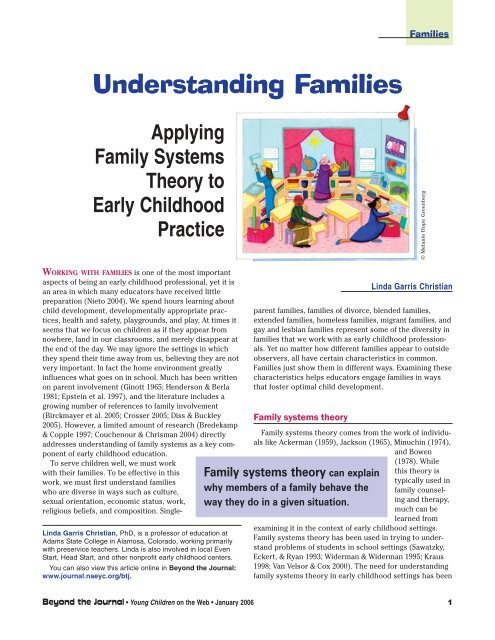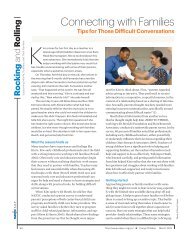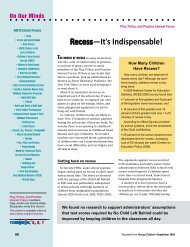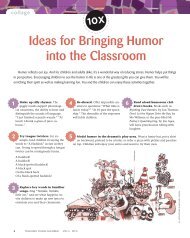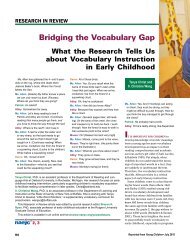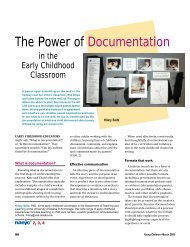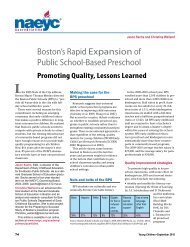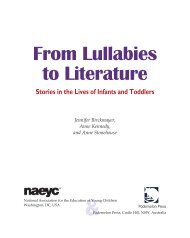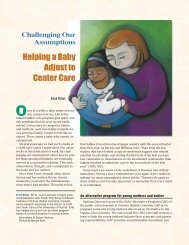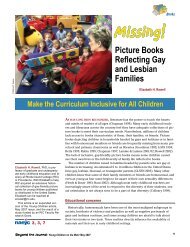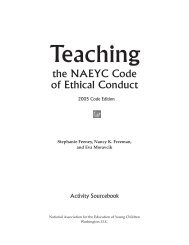Understanding Families - National Association for the Education of ...
Understanding Families - National Association for the Education of ...
Understanding Families - National Association for the Education of ...
You also want an ePaper? Increase the reach of your titles
YUMPU automatically turns print PDFs into web optimized ePapers that Google loves.
<strong>Understanding</strong> <strong>Families</strong><br />
Applying<br />
Family Systems<br />
Theory to<br />
Early Childhood<br />
Practice<br />
WORKING WITH FAMILIES is one <strong>of</strong> <strong>the</strong> most important<br />
aspects <strong>of</strong> being an early childhood pr<strong>of</strong>essional, yet it is<br />
an area in which many educators have received little<br />
preparation (Nieto 2004). We spend hours learning about<br />
child development, developmentally appropriate practices,<br />
health and safety, playgrounds, and play. At times it<br />
seems that we focus on children as if <strong>the</strong>y appear from<br />
nowhere, land in our classrooms, and merely disappear at<br />
<strong>the</strong> end <strong>of</strong> <strong>the</strong> day. We may ignore <strong>the</strong> settings in which<br />
<strong>the</strong>y spend <strong>the</strong>ir time away from us, believing <strong>the</strong>y are not<br />
very important. In fact <strong>the</strong> home environment greatly<br />
influences what goes on in school. Much has been written<br />
on parent involvement (Ginott 1965; Henderson & Berla<br />
1981; Epstein et al. 1997), and <strong>the</strong> literature includes a<br />
growing number <strong>of</strong> references to family involvement<br />
(Birckmayer et al. 2005; Crosser 2005; Diss & Buckley<br />
2005). However, a limited amount <strong>of</strong> research (Bredekamp<br />
& Copple 1997; Couchenour & Chrisman 2004) directly<br />
addresses understanding <strong>of</strong> family systems as a key component<br />
<strong>of</strong> early childhood education.<br />
To serve children well, we must work<br />
with <strong>the</strong>ir families. To be effective in this<br />
work, we must first understand families<br />
who are diverse in ways such as culture,<br />
sexual orientation, economic status, work,<br />
religious beliefs, and composition. Single-<br />
Linda Garris Christian, PhD, is a pr<strong>of</strong>essor <strong>of</strong> education at<br />
Adams State College in Alamosa, Colorado, working primarily<br />
with preservice teachers. Linda is also involved in local Even<br />
Start, Head Start, and o<strong>the</strong>r nonpr<strong>of</strong>it early childhood centers.<br />
You can also view this article online in Beyond <strong>the</strong> Journal:<br />
www.journal.naeyc.org/btj.<br />
<strong>Families</strong><br />
parent families, families <strong>of</strong> divorce, blended families,<br />
extended families, homeless families, migrant families, and<br />
gay and lesbian families represent some <strong>of</strong> <strong>the</strong> diversity in<br />
families that we work with as early childhood pr<strong>of</strong>essionals.<br />
Yet no matter how different families appear to outside<br />
observers, all have certain characteristics in common.<br />
<strong>Families</strong> just show <strong>the</strong>m in different ways. Examining <strong>the</strong>se<br />
characteristics helps educators engage families in ways<br />
that foster optimal child development.<br />
Family systems <strong>the</strong>ory<br />
Linda Garris Christian<br />
Family systems <strong>the</strong>ory comes from <strong>the</strong> work <strong>of</strong> individuals<br />
like Ackerman (1959), Jackson (1965), Minuchin (1974),<br />
and Bowen<br />
(1978). While<br />
Family systems <strong>the</strong>ory can explain<br />
why members <strong>of</strong> a family behave <strong>the</strong><br />
way <strong>the</strong>y do in a given situation.<br />
this <strong>the</strong>ory is<br />
typically used in<br />
family counseling<br />
and <strong>the</strong>rapy,<br />
much can be<br />
learned from<br />
examining it in <strong>the</strong> context <strong>of</strong> early childhood settings.<br />
Family systems <strong>the</strong>ory has been used in trying to understand<br />
problems <strong>of</strong> students in school settings (Sawatzky,<br />
Eckert, & Ryan 1993; Widerman & Widerman 1995; Kraus<br />
1998; Van Velsor & Cox 2000). The need <strong>for</strong> understanding<br />
family systems <strong>the</strong>ory in early childhood settings has been<br />
Beyond <strong>the</strong> Journal • Young Children on <strong>the</strong> Web January 2006 1<br />
© Melanie Hope Greenberg
underscored by pr<strong>of</strong>essional organizations in <strong>the</strong>ir guidelines<br />
<strong>for</strong> preparing early childhood and elementary pr<strong>of</strong>essionals<br />
(NAEYC, CEC/DEC, & NBPTS 1996; ACEI 1997a,b).<br />
A primary concept in family systems <strong>the</strong>ory is that <strong>the</strong><br />
family includes interconnected members, and each member<br />
influences <strong>the</strong> o<strong>the</strong>rs in predictable and recurring<br />
ways (Van Velsor & Cox 2000). From our families we learn<br />
skills that enable us to function in larger and more <strong>for</strong>mal<br />
settings, such as school and <strong>the</strong> workplace. Family experiences<br />
also shape our expectations <strong>of</strong> how <strong>the</strong> larger world<br />
will interact with us (Kern & Peluso 1999; Nieto 2004).<br />
Family systems <strong>the</strong>ory focuses on family behavior<br />
ra<strong>the</strong>r than individual behavior. The <strong>the</strong>ory considers<br />
communication and interaction patterns, separateness<br />
and connectedness, loyalty and independence, and adaptation<br />
to stress in <strong>the</strong> context <strong>of</strong> <strong>the</strong> whole as opposed to<br />
<strong>the</strong> individual in isolation. Family systems <strong>the</strong>ory can<br />
explain why members <strong>of</strong> a family behave <strong>the</strong> way <strong>the</strong>y do<br />
in a given situation (Fingerman & Bermann 2000). It is<br />
critical to use <strong>the</strong>se explanations to better serve children<br />
and families<br />
ra<strong>the</strong>r than <strong>for</strong><br />
<strong>the</strong> purpose <strong>of</strong><br />
blaming or<br />
trying to “fix”<br />
families.<br />
While <strong>the</strong>re<br />
are many aspects<br />
<strong>of</strong> <strong>the</strong><br />
<strong>the</strong>ory that<br />
could be applied<br />
in early<br />
childhood<br />
settings, I will<br />
limit this discussion<br />
to a few<br />
basics that I<br />
have found<br />
useful in my<br />
work with<br />
families and<br />
children. There<br />
are six characteristics<br />
<strong>of</strong> <strong>the</strong><br />
family as a<br />
system that are<br />
especially<br />
relevant <strong>for</strong> early childhood pr<strong>of</strong>essionals: boundaries,<br />
roles, rules, hierarchy, climate, and equilibrium. Each <strong>of</strong><br />
<strong>the</strong>se characteristics lies on a continuum. For example,<br />
while all families have rules, some have many and o<strong>the</strong>rs<br />
have few; some adhere strictly to rules and o<strong>the</strong>rs are<br />
inconsistent. While few families fall on <strong>the</strong> extreme end <strong>of</strong><br />
a continuum, <strong>the</strong>y do tend to be more to one side.<br />
© Ellen B. Senisi<br />
Boundaries<br />
<strong>Families</strong><br />
Eight-year-old Miguel knows about <strong>the</strong> call to his house today.<br />
His after-school program director, Mr. Chin, told him that unless<br />
his spelling improved, he would be ineligible to compete at <strong>the</strong><br />
city spelling meet. When <strong>the</strong> flyer on after-school classes came<br />
out in August, Miguel said he wanted to try pottery or chess.<br />
His mo<strong>the</strong>r insisted on his participation in <strong>the</strong> spelling bee and<br />
<strong>the</strong> challenging preparation <strong>for</strong> it. As he studied, Miguel felt a<br />
sense <strong>of</strong> pride in carrying on a family tradition. His mo<strong>the</strong>r,<br />
uncle, and older cousin had all won competitions when <strong>the</strong>y<br />
were his age. However, Miguel has been frustrated by <strong>the</strong> rigor<br />
<strong>of</strong> <strong>the</strong> activities and <strong>the</strong> lack <strong>of</strong> time <strong>for</strong> o<strong>the</strong>r interests. By <strong>the</strong><br />
time he gets home, a family meeting has already been planned<br />
to determine how best to help him to prepare. Miguel is nervous<br />
but knows his family will have good suggestions.<br />
When Miguel’s best friend, Mark, asked his mom which afterschool<br />
class to take, she responded, “Whatever you want.” Last<br />
year he tried and enjoyed swimming but got discouraged when<br />
his parents did not attend his meets. He signed up <strong>for</strong> <strong>the</strong><br />
spelling bee this year, but<br />
only so he could be with<br />
Miguel. He isn’t doing much<br />
better than Miguel, but when<br />
Mr. Chin calls Mark’s family,<br />
<strong>the</strong>ir response is quite<br />
different from that <strong>of</strong><br />
Miguel’s family. Mark’s dad<br />
takes <strong>the</strong> call and mentions it<br />
at dinner: “Mr. Chin called. It<br />
seems you’re not doing so<br />
well with <strong>the</strong> spelling thing.<br />
Is <strong>the</strong>re anything we can do<br />
to help?” Mark says, “No, I’m<br />
just tired <strong>of</strong> school stuff by<br />
<strong>the</strong> end <strong>of</strong> <strong>the</strong> day. Next time<br />
I’m going to try a sport or<br />
maybe chess.” Mark’s mom<br />
replies, “Sounds like a good<br />
plan, but what about Miguel?”<br />
Mark shrugs, “I did <strong>the</strong><br />
spelling with him to keep him<br />
company. Maybe next time<br />
he’ll do something with me.”<br />
Boundaries relate to<br />
limits, toge<strong>the</strong>rness, and separateness—what or who is<br />
“in” or “out <strong>of</strong>” <strong>the</strong> family (Walsh & Giblin 1988). Some<br />
families are open to new people, in<strong>for</strong>mation, and ideas.<br />
Family members tend to be independent and able to make<br />
decisions on <strong>the</strong>ir own. They value separateness and<br />
autonomy over a sense <strong>of</strong> belonging. Each person’s identity<br />
is encouraged and respected. These families are<br />
sometimes described as disengaged. In o<strong>the</strong>r families<br />
Beyond <strong>the</strong> Journal Young Children on <strong>the</strong> Web January 2006 2
oundaries tend to be more closed and restrictive; <strong>the</strong><br />
families emphasize toge<strong>the</strong>rness, belonging, emotional<br />
connectedness, and at<br />
times, con<strong>for</strong>mity. They<br />
Boundaries relate to limits, toge<strong>the</strong>rness,<br />
and separateness—what or<br />
who is “in” or “out <strong>of</strong>” <strong>the</strong> family.<br />
may control ra<strong>the</strong>r than<br />
monitor <strong>the</strong>ir children’s<br />
friends and activities.<br />
Discipline is one way a<br />
family can en<strong>for</strong>ce <strong>the</strong><br />
boundaries within <strong>the</strong><br />
family (Kern & Peluso 1999). Behaviors are seen as a<br />
reflection on <strong>the</strong> family, not just <strong>the</strong> individual. These<br />
families are sometimes referred to as enmeshed. An<br />
individual’s identity is very much tied to <strong>the</strong> family when<br />
he or she is part <strong>of</strong> an enmeshed family.<br />
Early childhood pr<strong>of</strong>essionals should remain open when<br />
thinking about <strong>the</strong>se two types <strong>of</strong> families. One is not<br />
positive and <strong>the</strong> o<strong>the</strong>r negative; <strong>the</strong> types are just different<br />
from each o<strong>the</strong>r. <strong>Families</strong> may show signs and degrees <strong>of</strong><br />
each type; this may vary at any given point, depending on<br />
factors such as age <strong>of</strong> <strong>the</strong> children, economic circumstances,<br />
and <strong>the</strong> family’s stage <strong>of</strong> development (<strong>for</strong> example,<br />
first-time parents versus a family with several<br />
children). O<strong>the</strong>r factors, including <strong>the</strong> families in which<br />
<strong>the</strong> parents grew up, <strong>the</strong> social and political climate <strong>of</strong> <strong>the</strong><br />
times, <strong>the</strong> culture and values <strong>of</strong> <strong>the</strong> family, and health or<br />
mental issues in <strong>the</strong> family, also influence <strong>the</strong> degree <strong>of</strong><br />
enmeshment or disengagement. Over time families may<br />
change from one style to ano<strong>the</strong>r. For example, during<br />
times <strong>of</strong> stress and crisis a family that had operated in a<br />
disengaged manner may move toward a more closed<br />
system.<br />
Miguel’s family is closer to <strong>the</strong> enmeshed end <strong>of</strong> <strong>the</strong><br />
continuum while Mark’s family tends to be more disengaged.<br />
Mark may sometimes wish his parents would become<br />
more involved with his activities, while Miguel may<br />
secretly wish his family would occasionally keep <strong>the</strong>ir opinions<br />
to <strong>the</strong>mselves! The family’s involvement in his preparation<br />
<strong>for</strong> <strong>the</strong> competition indicates <strong>the</strong>ir enmeshment.<br />
In a conversation with Mark’s parents about next term’s<br />
activities, you may learn that while Mark’s mo<strong>the</strong>r thinks<br />
sports would help his lagging physical development, his<br />
fa<strong>the</strong>r fears self-esteem issues could arise if Mark struggles<br />
because <strong>of</strong> this lag. However, both feel that it is Mark’s<br />
decision and <strong>the</strong>y will support it. Mark’s family’s disengagement<br />
works to foster his independence and develop<br />
his identity, while Miguel’s identity is closely related to<br />
that <strong>of</strong> his family.<br />
As an educator, you would foster both Miguel’s and<br />
Mark’s sense <strong>of</strong> identity while respecting <strong>the</strong>ir families:<br />
share what you know about each boy’s real strengths with<br />
<strong>the</strong>m and <strong>the</strong>ir families. Help each child and his family to<br />
see <strong>the</strong> characteristics that make him unique and wonderful.<br />
Work with Miguel to identify family rituals, traditions,<br />
<strong>Families</strong><br />
and values in which he believes. Help him find ways to<br />
appreciate and honor his family’s support. As Mark’s<br />
teacher you may plan activities<br />
that allow his family to see Mark’s<br />
uniqueness or activities that lend<br />
<strong>the</strong>mselves to family involvement.<br />
Help Mark to see <strong>the</strong> ways in<br />
which his family does support his<br />
development.<br />
Ideas <strong>for</strong> working with families—Boundaries<br />
1. Recognize different parenting styles and family boundaries.<br />
Educators <strong>of</strong>ten perceive <strong>the</strong> family who comes to<br />
meetings and responds with active and enthusiastic involvement<br />
and participation (helps with learning or discipline<br />
issues, provides materials <strong>for</strong> a special project, serves<br />
as a volunteer) as more caring and as a “good family.” The<br />
family who responds politely to requests but leaves day-today<br />
decisions and work on school matters to <strong>the</strong> child and<br />
teacher (allows child to experience consequences due to<br />
lack <strong>of</strong> preparation <strong>for</strong> a quiz or <strong>for</strong>getting <strong>the</strong>ir share item<br />
<strong>for</strong> <strong>the</strong> day) is seen as less caring and uninvolved. Build on<br />
family strengths and avoid labeling and allowing personal<br />
bias to influence your interactions with families.<br />
2. Avoid stereotypes. Just because a student is <strong>of</strong> a<br />
certain culture does not automatically mean that student’s<br />
family is <strong>of</strong> a given religion, does not have legal status, has<br />
a certain discipline style, or has a specific socioeconomic<br />
status (Kagan & Garcia 1991). It is critical <strong>for</strong> teachers to<br />
become familiar with <strong>the</strong> cultural background <strong>of</strong> individual<br />
students.<br />
3. Recognize that <strong>for</strong> some families everything is a<br />
family affair. Be sure to have enough chairs, snacks, and<br />
materials to accommodate extended families at events and<br />
conferences. For some families, an invitation to family<br />
night includes aunts, uncles, cousins, friends who serve as<br />
family, and even neighbors (Trawick-Smith 2005).<br />
4. Balance children’s activities and curriculum to incorporate<br />
both individual and group identity. Whe<strong>the</strong>r <strong>the</strong>ir<br />
families are disengaged or enmeshed, children need<br />
opportunities to experience who <strong>the</strong>y are individually and<br />
as a part <strong>of</strong> a group.<br />
5. Respect families’ need <strong>for</strong> control. When introducing<br />
new ideas, materials, or experiences to children, involve<br />
families as well. Also recognize that some family members<br />
did not have positive experiences with education as <strong>the</strong>y<br />
were growing up. While <strong>the</strong>y may display anger, hostility,<br />
or mistrust, and <strong>the</strong>se may be directed at you, <strong>the</strong> source<br />
may be events from <strong>the</strong> past. It will take time and persistence<br />
to build a relationship with <strong>the</strong>se families. Teachers<br />
need to demonstrate that families can depend on and trust<br />
<strong>the</strong>m to help in <strong>the</strong> education <strong>of</strong> <strong>the</strong>ir children.<br />
Beyond <strong>the</strong> Journal Young Children on <strong>the</strong> Web January 2006 3
Roles<br />
“Lela, go and join <strong>the</strong> o<strong>the</strong>rs on <strong>the</strong> playground. I’ll finish <strong>the</strong> rest<br />
<strong>of</strong> cleanup <strong>for</strong> you. You’ve been a big help today,” says Kathy as<br />
she hugs <strong>the</strong> four-year-old. Lela hesitates at <strong>the</strong> door and asks,<br />
“Are you sure?” Kathy smiles reassuringly. “Yes, now go play!”<br />
Once on <strong>the</strong> playground, Lela pushes Sadie, one <strong>of</strong> <strong>the</strong><br />
younger children, on <strong>the</strong> swing. When Sadie tires <strong>of</strong> swinging<br />
and goes <strong>of</strong>f to play in <strong>the</strong> sand, Lela helps <strong>the</strong> teacher carry<br />
toys from <strong>the</strong><br />
storage shed to set<br />
up an activity. Later,<br />
Lela mediates a<br />
dispute over tricycles<br />
between two<br />
classmates. A<br />
visiting teacher<br />
taking anecdotal<br />
notes that day<br />
writes, “Lela’s play<br />
was limited to<br />
‘helping’ <strong>for</strong> outdoor<br />
playtime and much<br />
<strong>of</strong> <strong>the</strong> rest <strong>of</strong> <strong>the</strong><br />
day. How can we<br />
encourage her to<br />
expand her play<br />
activities to include<br />
o<strong>the</strong>r roles?”<br />
In all families,<br />
individual members<br />
have roles (Walsh &<br />
Giblin 1988;<br />
Tarnowski-Goodell,<br />
Hanson, & May<br />
1999; Fingerman &<br />
Bermann 2000). There is usually a peacemaker, a clown, a<br />
rescuer, and a victim, although <strong>the</strong>re can be many o<strong>the</strong>r<br />
roles as well. Each role has certain behavioral expectations.<br />
For example, if someone is <strong>the</strong> responsible one<br />
within <strong>the</strong> family, this person has a tendency to fix<br />
problems and take care <strong>of</strong> o<strong>the</strong>rs, and o<strong>the</strong>rs depend on<br />
him. The victim in <strong>the</strong> family is <strong>the</strong> person who gets<br />
blamed <strong>for</strong> everything. This person <strong>of</strong>ten acts out in ways<br />
that are sure to bring responses <strong>of</strong> anger, threats, and<br />
punishment.<br />
Family roles can be carried over to work, school, and<br />
social settings. A child who has spent four years practicing<br />
every day to be <strong>the</strong> peacemaker will bring those skills to<br />
<strong>the</strong> classroom. While each role can have positive behavior,<br />
<strong>the</strong>re can also be negative consequences. For example, if<br />
<strong>the</strong> responsible person in <strong>the</strong> family always solves <strong>the</strong><br />
problems, o<strong>the</strong>rs do not have opportunities to develop<br />
problem-solving skills.<br />
© Ellen B. Senisi<br />
<strong>Families</strong><br />
Lela has a clear idea <strong>of</strong> her role in her family: she is a<br />
helper. Helping is a wonderful attribute and not one that<br />
teachers want to disappear. Having Lela teach o<strong>the</strong>rs how<br />
to help is a way to build on her strength. To facilitate her<br />
whole-child development, teachers could set up a situation<br />
that does not lend itself to her helping anyone and<br />
encourage her play in that area. They could also refuse<br />
some <strong>of</strong> her <strong>of</strong>fers to help, but with careful wording. For<br />
example, “You were such a great help yesterday, you<br />
deserve a day <strong>of</strong>f<br />
today! But you can<br />
choose someone to do<br />
this job today.”<br />
Lela’s teachers will<br />
need patience, consistency,<br />
and creative<br />
ideas to help her learn<br />
new roles. Look <strong>for</strong><br />
her o<strong>the</strong>r strengths<br />
and channel her energies<br />
in that direction.<br />
For example, Lela has<br />
strong fine motor<br />
skills; she could be<br />
paired with a child<br />
who is creative to<br />
design and construct<br />
new signs <strong>for</strong> <strong>the</strong> play<br />
areas. It is also important<br />
to find ways to<br />
share positive in<strong>for</strong>mation<br />
with Lela’s family<br />
that allow <strong>the</strong>m to<br />
foster opportunities<br />
<strong>for</strong> new roles at home.<br />
Ideas <strong>for</strong> working with families—Roles<br />
1. Give children ample opportunity <strong>for</strong> role play, in<br />
both structured and unstructured situations. Children<br />
need to experience new roles as well as work through <strong>the</strong>ir<br />
current roles. Recognize <strong>the</strong> importance <strong>of</strong> children’s<br />
cultural backgrounds in <strong>the</strong> roles <strong>the</strong>y adopt (Noel 2000;<br />
Garcia 2002).<br />
2. Observe children carefully. Many “problems” that<br />
educators identify are very role bound. A child who seems<br />
to be a magnet <strong>for</strong> disruptive events may be <strong>the</strong> child who<br />
Family roles can be carried over to<br />
work, school, and social settings.<br />
Beyond <strong>the</strong> Journal Young Children on <strong>the</strong> Web January 2006 4
gets blamed <strong>for</strong> everything at home. Set up situations <strong>for</strong><br />
that child to see herself in different roles. For example,<br />
engage <strong>the</strong> child in working with you to negotiate a dispute<br />
between two o<strong>the</strong>r children or allow <strong>the</strong> child to lead<br />
an activity.<br />
3. Help families recognize <strong>the</strong>ir children’s many and<br />
varied strengths. A note home might read, “Sally taught Ki<br />
how to put on his shoes today! She was a very good<br />
teacher” or “I appreciate Ricky’s sense <strong>of</strong> humor. He always<br />
makes us smile!”<br />
Rules<br />
Jason teaches a toddlers’ class. Soon after parents Sam and<br />
Imelda met at a party, <strong>the</strong>y began sharing rides and helping each<br />
o<strong>the</strong>r out on weekends. The relationship blossomed into something<br />
more than two single parents sharing <strong>the</strong> trials and tribulations<br />
<strong>of</strong> <strong>the</strong>ir two-year-olds. The two families have recently joined<br />
toge<strong>the</strong>r as one.<br />
As <strong>the</strong> assistant director, Jason needs to<br />
find out which families need child care over<br />
an upcoming holiday. When he broaches<br />
<strong>the</strong> subject with Sam and Imelda, he detects<br />
a stony silence. Finally Sam says, “I<br />
thought it would be nice <strong>for</strong> our first<br />
holiday to go away toge<strong>the</strong>r with <strong>the</strong><br />
children. My uncle has <strong>of</strong>fered <strong>the</strong> use <strong>of</strong><br />
his house in <strong>the</strong> mountains.” Imelda chimes<br />
in quickly, “But I’ve always spent <strong>the</strong><br />
holidays with my family here in town. It’s<br />
just expected that everybody will be <strong>the</strong>re.<br />
If someone doesn’t, <strong>the</strong>y hear about it <strong>for</strong><br />
years.”<br />
Jason remembers a huge fight with his<br />
wife <strong>the</strong> first year after <strong>the</strong>y became<br />
parents. It was about when to open<br />
Christmas presents. He understands Sam<br />
and Imelda’s dilemma, but he isn’t sure how<br />
to support <strong>the</strong>m as a new family.<br />
Rules are sets <strong>of</strong> standards, laws,<br />
or traditions that tell us how to live in<br />
relation to each o<strong>the</strong>r. Our patterns<br />
and rules <strong>for</strong> interaction have longterm<br />
and far-reaching effects. For<br />
example, if we believe in <strong>the</strong> predictability<br />
<strong>of</strong> life, we tend to plan ahead.<br />
If we believe what happens is out <strong>of</strong><br />
our control, we may deal with circumstances as <strong>the</strong>y arise<br />
ra<strong>the</strong>r than trying to prevent or avoid problems<br />
(Fingerman & Bermann 2000).<br />
Rules may be spoken or unspoken. If we have been<br />
in<strong>for</strong>med about a rule, we can discuss, problem solve, and<br />
make choices. If we are unaware <strong>of</strong> a rule, we may behave<br />
© Skjold Photography<br />
<strong>Families</strong><br />
in ways that are not consistent with that rule. We usually<br />
find out about an unspoken rule by breaking it and <strong>the</strong>n<br />
experiencing <strong>the</strong> consequences. Rules are <strong>of</strong>ten embedded<br />
in a cultural context; <strong>the</strong>re<strong>for</strong>e, <strong>the</strong>y can contribute to <strong>the</strong><br />
feeling <strong>of</strong> cultural discontinuity that some children experience<br />
at school. When home and school cultures conflict,<br />
misunderstandings and even hostility can occur <strong>for</strong> children,<br />
families, and teachers (Delpit 1995; Noel 2000). Sam<br />
and Imelda are experiencing problems with procedural<br />
kinds <strong>of</strong> rules. Jason needs to support this family in a<br />
positive way without crossing pr<strong>of</strong>essional and personal<br />
boundaries. There may be resources to which he can<br />
direct <strong>the</strong>m.<br />
Jason must be very careful in how he responds; he is<br />
not a counselor. Is this a simple issue, or is it one in which<br />
<strong>the</strong> family may need outside help? Jason can share his<br />
experience—that he and his wife found it helpful to talk to<br />
<strong>the</strong>ir priest, and that <strong>the</strong> center resource director has a<br />
list <strong>of</strong> local counselors<br />
that o<strong>the</strong>r<br />
families have used<br />
in <strong>the</strong> past. On a<br />
practical level he<br />
can acknowledge<br />
<strong>the</strong> importance <strong>of</strong><br />
bringing both<br />
familiar rituals to<br />
<strong>the</strong> new family as<br />
well as new<br />
experiences that<br />
will bond <strong>the</strong><br />
members toge<strong>the</strong>r.<br />
He can encourage<br />
Sam and Imelda to<br />
keep talking and<br />
listening to each<br />
o<strong>the</strong>r so that <strong>the</strong>y<br />
can determine what<br />
is important to<br />
each <strong>of</strong> <strong>the</strong>m.<br />
Ideas <strong>for</strong><br />
working with<br />
families—Rules<br />
1. Make distinctions<br />
between<br />
home rules and<br />
school rules. When children challenge you on a specific<br />
school rule, it may be because it differs from home rules.<br />
Proceed carefully; it is critical to respect <strong>the</strong> home environment.<br />
For example, you may allow children to serve<br />
<strong>the</strong>mselves at mealtimes, although at home <strong>the</strong>ir plates<br />
are prepared by adults.<br />
Beyond <strong>the</strong> Journal Young Children on <strong>the</strong> Web January 2006 5
Rules are <strong>of</strong>ten embedded in a<br />
cultural context; <strong>the</strong>re<strong>for</strong>e, <strong>the</strong>y can contribute<br />
to <strong>the</strong> feeling <strong>of</strong> cultural discontinuity<br />
that some children experience at school.<br />
2. Watch <strong>for</strong> unspoken rules, especially those related to<br />
gender, power, and how we treat each o<strong>the</strong>r; discuss <strong>the</strong>m<br />
with care. While you may want girls and boys to enjoy<br />
cooking experiences, recognize that in some traditional<br />
families this may create a conflict. Discuss <strong>the</strong> skills, rationale,<br />
and benefits <strong>for</strong> children and families. You may uncover<br />
alternate activities that meet <strong>the</strong> goals <strong>of</strong> all.<br />
3. Ask <strong>for</strong> families’ input and assistance when conflict<br />
arises over rules. Explain <strong>the</strong> reasons behind school rules<br />
and, equally important, listen to <strong>the</strong> family. They can share<br />
in<strong>for</strong>mation that may help resolve a problem or address<br />
changes that may need to be made in school rules. They<br />
may also be willing to modify home rules or talk with <strong>the</strong>ir<br />
child about <strong>the</strong> differences between home and school.<br />
Hierarchy<br />
Nancy, a preschool teacher, notices that <strong>the</strong> Hudson family has<br />
been ra<strong>the</strong>r short with her and almost cold since <strong>the</strong> last family<br />
meeting. Up until now <strong>the</strong>y had been supportive and friendly.<br />
Puzzled, she schedules an appointment with Kate, <strong>the</strong> center<br />
director. Kate thoughtfully listens to Nancy’s dilemma, and<br />
toge<strong>the</strong>r <strong>the</strong>y re-create <strong>the</strong> events <strong>of</strong> <strong>the</strong> last meeting with families.<br />
After much thought, <strong>the</strong>y focus on one activity. Several<br />
teachers had presented three curriculum designs on which <strong>the</strong>y<br />
wanted family input. A couple <strong>of</strong> parents had given ideas, but<br />
<strong>the</strong>n <strong>the</strong> communication stopped. In an ef<strong>for</strong>t to get things<br />
going again, Nancy had said, “Mrs. Hudson, you and Mr.<br />
Hudson have been active volunteers and observers <strong>of</strong> our<br />
curriculum <strong>for</strong> several months now. What do<br />
you think?” While Mr. Hudson <strong>of</strong>fered<br />
several ideas, Mrs. Hudson averted her eyes<br />
and did not respond. Thinking back, Kate<br />
and Nancy remember Mr. Hudson looked<br />
ra<strong>the</strong>r startled and almost angry. But what<br />
was <strong>the</strong> source <strong>of</strong> this animosity?<br />
Hierarchy helps answer <strong>the</strong> question<br />
“Who’s <strong>the</strong> boss?” This characteristic is<br />
related to decision making, control, and power in <strong>the</strong><br />
family. In some families, <strong>the</strong> hierarchy is a parental one.<br />
The parents share family responsibilities. One may defer<br />
to <strong>the</strong> o<strong>the</strong>r based on a specific situation or individual<br />
strength, but <strong>the</strong>re is a definite balance and trading back<br />
and <strong>for</strong>th <strong>of</strong> power and control. Early childhood pr<strong>of</strong>es-<br />
<strong>Families</strong><br />
sionals may also observe family hierarchies based on<br />
gender and age and influenced by culture, religion, or<br />
economic status. At times <strong>the</strong>re may be a clear and<br />
strong message but o<strong>the</strong>r times it may be difficult to<br />
discern. You may observe at <strong>the</strong> center’s family<br />
picnic that <strong>the</strong> males are seated, served, and encouraged<br />
to eat first. In o<strong>the</strong>r families, <strong>the</strong> elder grandmo<strong>the</strong>r<br />
may be <strong>the</strong> decision maker, and everyone<br />
may look to her <strong>for</strong> leadership and guidance. The role<br />
<strong>of</strong> extended family in understanding hierarchy may<br />
be very important in some families (Morton 2000).<br />
Early childhood pr<strong>of</strong>essionals need to understand<br />
hierarchy because <strong>of</strong> <strong>the</strong> diversity <strong>of</strong> families with whom<br />
we work. Each time <strong>the</strong> family composition changes, <strong>the</strong>re<br />
is a shift in where family members are in <strong>the</strong> hierarchy. For<br />
example, one family consists <strong>of</strong> a child, a younger sibling,<br />
a mo<strong>the</strong>r, and a grandmo<strong>the</strong>r at <strong>the</strong> beginning <strong>of</strong> <strong>the</strong> year.<br />
After a mid-year marriage, <strong>the</strong> family home has <strong>the</strong> child,<br />
<strong>the</strong> sibling, <strong>the</strong> mo<strong>the</strong>r, <strong>the</strong> grandmo<strong>the</strong>r, <strong>the</strong> new fa<strong>the</strong>r<br />
figure, and two new older stepsiblings. The hierarchy has<br />
changed. In families with large extended kin networks,<br />
hierarchy can be confusing to outsiders.<br />
The Hudson family may feel that Nancy and her colleagues<br />
did not respect <strong>the</strong> hierarchy in <strong>the</strong>ir family.<br />
There are two issues <strong>for</strong> Nancy and her colleagues: prevention<br />
and repair. In terms <strong>of</strong> prevention, <strong>the</strong>y could add<br />
some items to <strong>the</strong> in<strong>for</strong>mation sheets distributed at <strong>the</strong><br />
beginning <strong>of</strong> <strong>the</strong> year and returned by each family that<br />
respectfully ask about how <strong>the</strong> family would like to be<br />
approached in certain situations. Sample items might read:<br />
Decisions about children in our family are usually<br />
made by _____________.<br />
How and with whom would you like in<strong>for</strong>mation about<br />
your child shared?<br />
We want to respect your family in our work with you<br />
and your child at this center. Please share any<br />
in<strong>for</strong>mation that you feel will help us in <strong>the</strong>se ef<strong>for</strong>ts.<br />
Most important, Nancy<br />
and her colleagues should<br />
make conscious ef<strong>for</strong>ts to<br />
observe families and <strong>the</strong>ir<br />
children in center activities,<br />
social ga<strong>the</strong>rings at <strong>the</strong><br />
center, and in home visits to<br />
notice cues <strong>the</strong> family gives<br />
as to <strong>the</strong> hierarchy. They can<br />
become “family watchers” in<br />
addition to being “child watchers.” For example, does a<br />
mo<strong>the</strong>r always defer to <strong>the</strong> grandmo<strong>the</strong>r on questions that<br />
<strong>the</strong> teacher asks?<br />
To repair <strong>the</strong> relationship with <strong>the</strong> Hudsons, Nancy and<br />
her colleagues will need to be sincere, diligent, and focused<br />
on respect and what is best <strong>for</strong> <strong>the</strong> child and family.<br />
Each time <strong>the</strong> family<br />
composition changes, <strong>the</strong>re<br />
is a shift in where family<br />
members are in <strong>the</strong> hierarchy.<br />
Beyond <strong>the</strong> Journal Young Children on <strong>the</strong> Web January 2006 6
If conferences with <strong>the</strong> family don’t illicit a response that<br />
allows Nancy to address <strong>the</strong> change in <strong>the</strong>ir behavior, she<br />
may choose to directly state her concern that she has<br />
<strong>of</strong>fended <strong>the</strong>m in some way. She may ask <strong>for</strong> <strong>the</strong>ir help in<br />
understanding so that she will not repeat her mistake and<br />
stress how much she values and respects <strong>the</strong> family as<br />
part <strong>of</strong> her classroom. She may communicate to <strong>the</strong>m how<br />
vital <strong>the</strong>y are to <strong>the</strong> success <strong>of</strong> <strong>the</strong> program and especially<br />
to <strong>the</strong>ir children. She may also ask if <strong>the</strong>y have a need that<br />
she has failed to address.<br />
Ideas <strong>for</strong> working with families—Hierarchy<br />
1. Engage in careful and keen observation. “Family<br />
watching” is essential. Who signs <strong>the</strong> permission <strong>for</strong>ms?<br />
Who returns <strong>the</strong> phone call? How does <strong>the</strong> child role-play<br />
his family members in dramatic play? Does a youngster<br />
assume that a male teacher is <strong>the</strong> boss <strong>of</strong> <strong>the</strong> female<br />
teachers? While answers to <strong>the</strong>se<br />
questions are not always indicative<br />
<strong>of</strong> hierarchy, <strong>the</strong>y may <strong>of</strong>fer clues.<br />
2. Note <strong>the</strong> signs that a family’s<br />
hierarchy is in <strong>the</strong> process <strong>of</strong><br />
changing. Be aware that children<br />
can respond by testing hierarchy in<br />
<strong>the</strong> classroom. A child who <strong>of</strong>ten<br />
leads at school may appear lost or<br />
unsure <strong>of</strong> herself as a new stepbro<strong>the</strong>r<br />
takes her place “in charge”<br />
<strong>of</strong> younger siblings. Help her to<br />
reclaim her confidence through<br />
activities that allow her to experience<br />
success.<br />
3. Watch out <strong>for</strong> hierarchies<br />
emerging in <strong>the</strong> classroom and on<br />
<strong>the</strong> playground. While hierarchy<br />
can lead to a sense <strong>of</strong> order and<br />
security, it can also lead to a pecking<br />
order and in <strong>the</strong> worst cases,<br />
bullying. Avoid activities that rein<strong>for</strong>ce<br />
<strong>the</strong> same hierarchy over time.<br />
Vary activities so that different<br />
children’s strengths are showcased.<br />
Climate<br />
Climate is about <strong>the</strong> emotional and physical environments<br />
a child grows up in. Some families compensate <strong>for</strong><br />
hurtful or inadequate parts <strong>of</strong> <strong>the</strong> environment, such as<br />
living in a dangerous neighborhood, as best as <strong>the</strong>y can<br />
(Nieto 2004). O<strong>the</strong>r families have <strong>the</strong> best that money can<br />
buy, but <strong>the</strong> emotional quality <strong>of</strong> <strong>the</strong> home environment is<br />
not optimal <strong>for</strong> <strong>the</strong> children. The culture, economic status,<br />
or educational level <strong>of</strong> <strong>the</strong> family does not cause <strong>the</strong><br />
emotional quality <strong>of</strong> <strong>the</strong> environment to be positive or<br />
<strong>Families</strong><br />
negative. Emotional quality is related to beliefs about<br />
children and families. To determine <strong>the</strong> climate <strong>of</strong> a family<br />
system, consider <strong>the</strong> answers to <strong>the</strong> following questions:<br />
What would it feel like to be a child in this family? Would I<br />
feel safe, secure, loved, encouraged, and supported? Or<br />
would I feel scared, fearful, angry, hated, and unhappy?<br />
Ideas <strong>for</strong> working with families—Climate<br />
1. Provide opportunities <strong>for</strong> families to discuss <strong>the</strong>ir<br />
beliefs about children, what <strong>the</strong>y want <strong>for</strong> <strong>the</strong>ir children,<br />
and how <strong>the</strong>y support <strong>the</strong>ir children’s development. Staff<br />
can facilitate at <strong>the</strong> events. These discussions help teachers<br />
learn how <strong>the</strong>y can best support families as <strong>the</strong> families<br />
support <strong>the</strong>ir children (Delpit 1995; Garcia 2001). An<br />
additional benefit is that families <strong>of</strong>ten value in<strong>for</strong>mation<br />
and advice from <strong>the</strong>ir peers more than through a lecture<br />
on good<br />
parenting.<br />
Climate is about<br />
<strong>the</strong> emotional and<br />
physical environments<br />
a child grows up in.<br />
2. Create a<br />
classroom<br />
climate <strong>of</strong><br />
safety, positive<br />
feedback<br />
and guidelines,<br />
and<br />
healthy sensory<br />
experiences. Even<br />
if home environments do<br />
not <strong>of</strong>fer <strong>the</strong>se (or especially!),<br />
children need to<br />
feel school is a wonderful<br />
place to be.<br />
Equilibrium<br />
It is critical <strong>for</strong> early<br />
childhood pr<strong>of</strong>essionals<br />
to understand <strong>the</strong> balance<br />
or sense <strong>of</strong> equilibrium<br />
within a family.<br />
Changes or inconsistency<br />
in a family can<br />
create confusion or<br />
resentment in its members, including children (Kern &<br />
Peluso 1999). Consistency in families can be difficult to<br />
maintain, but it is essential to children’s development <strong>of</strong> a<br />
sense <strong>of</strong> security and trust. Rituals and customs <strong>of</strong>ten<br />
keep a family toge<strong>the</strong>r during times <strong>of</strong> change and stress<br />
(Fingerman & Bermann 2000). All families, even ones with<br />
ongoing difficulties, have a sort <strong>of</strong> balance that tells members<br />
what to expect. When <strong>the</strong>re is change, positive or<br />
negative, it impacts <strong>the</strong> balance <strong>of</strong> <strong>the</strong> family. That is one<br />
reason change is so difficult to maintain.<br />
Beyond <strong>the</strong> Journal Young Children on <strong>the</strong> Web January 2006 7<br />
© Skjold Photography
For example, in a family where sweets, fried foods, and<br />
lots <strong>of</strong> bread are meal staples, a family member with a<br />
heart condition is told to change to a healthier diet. While<br />
o<strong>the</strong>r family members may wish to be supportive, it can be<br />
difficult. They may resent that <strong>the</strong>ir eating habits must<br />
change too, because preparing two meals is usually not<br />
feasible.<br />
Ideas <strong>for</strong> working with families—Equilibrium<br />
1. Consider inviting a trained family pr<strong>of</strong>essional to<br />
facilitate discussion when a big change or issue is impacting<br />
a number <strong>of</strong><br />
families (<strong>for</strong><br />
example, a bond<br />
issue will impact<br />
<strong>the</strong> public<br />
schools <strong>the</strong><br />
children attend).<br />
<strong>Families</strong> need to<br />
have safe places<br />
to vent, discuss,<br />
and talk about <strong>the</strong>ir changing worlds.<br />
2. Provide as much consistency as possible when you<br />
are aware <strong>of</strong> changes within a family (a new baby or sick<br />
grandparent). This is usually not a good time to change<br />
<strong>the</strong> routine, rearrange <strong>the</strong> classroom, or introduce new<br />
staff. Recognize that in some cases, <strong>the</strong> teacher, <strong>the</strong> environment,<br />
and <strong>the</strong> school routine are <strong>the</strong> most stable <strong>for</strong>ces<br />
in <strong>the</strong> child’s life.<br />
3. Encourage families to plan ways to increase stability<br />
and security. For example, parents may have to meet <strong>the</strong><br />
needs <strong>of</strong> <strong>the</strong>ir young children while also caring <strong>for</strong> an<br />
older relative in failing health. Never<strong>the</strong>less, <strong>the</strong>y can set<br />
aside time <strong>for</strong> a bedtime routine that involves reading a<br />
story and talking about <strong>the</strong> day’s events.<br />
Conclusion<br />
The suggestions in this article are not absolutes nor<br />
meant to be perfect. Each family is unique, as is each<br />
teacher. Some educators are com<strong>for</strong>table with direct<br />
interactions, while o<strong>the</strong>rs <strong>of</strong> us need to begin discussions<br />
with an activity that demonstrates our connections to and<br />
caring <strong>for</strong> families be<strong>for</strong>e tackling <strong>the</strong>se kinds <strong>of</strong> conversations.<br />
While establishing relationships with families be<strong>for</strong>e<br />
problems arise is essential, it doesn’t always happen. We<br />
need nonconfrontational ways to broach sensitive topics.<br />
The keys to win-win resolutions are awareness, willingness,<br />
sincerity, and respect. Making an ef<strong>for</strong>t to understand<br />
families will open up opportunities <strong>for</strong> you to better<br />
serve children and <strong>the</strong>ir families.<br />
References<br />
Consistency in families can<br />
be difficult to maintain, but it is<br />
critical to children’s development <strong>of</strong><br />
a sense <strong>of</strong> security and trust.<br />
Copyright © 2006 by <strong>the</strong> <strong>National</strong> <strong>Association</strong> <strong>for</strong> <strong>the</strong> <strong>Education</strong> <strong>of</strong> Young Children.<br />
See Permissions and Reprints online at www.journal.naeyc.org/about/permissions.asp.<br />
<strong>Families</strong><br />
ACEI (<strong>Association</strong> <strong>for</strong> Childhood <strong>Education</strong> International). 1997a.<br />
Preparation <strong>of</strong> early childhood teachers. Childhood <strong>Education</strong> 73<br />
(3): 164–65.<br />
ACEI (<strong>Association</strong> <strong>for</strong> Childhood <strong>Education</strong> International). 1997b.<br />
Preparation <strong>of</strong> elementary teachers. Childhood <strong>Education</strong> 73 (3):<br />
166–67.<br />
Ackerman, N. 1959. Theory <strong>of</strong> family dynamics. Psychoanalysis<br />
and <strong>the</strong> Psychoanalytic Review 46 (4): 33–50.<br />
Birckmayer, J., J. Cohen, I. Jensen, & D. Variano. 2005. Supporting grandparents<br />
who raise grandchildren. Young Children 60 (3): 100–04.<br />
Bowen, M. 1978. Family <strong>the</strong>rapy in clinical practice. New York:<br />
Jason Aronson.<br />
Bredekamp, S., & C. Copple, eds. 1997. Developmentally appropriate<br />
practice in early childhood programs. Rev. ed. Washington,<br />
DC: NAEYC.<br />
Couchenour, D., & K. Chrisman. 2004. <strong>Families</strong>,<br />
schools, and communities: Toge<strong>the</strong>r <strong>for</strong> young<br />
children. Canada: Delmar Learning.<br />
Crosser, S. 2005. What do we know about early childhood<br />
education? Research based practice. Clifton Park, NY:<br />
Thomson Delmar Learning.<br />
Delpit, L. 1995. O<strong>the</strong>r people’s children: Cultural conflict<br />
in <strong>the</strong> classroom. New York: The New Press.<br />
Diss, R., & P. Buckley. 2005. Developing family and community<br />
involvement skills through case studies and field<br />
experiences. Upper Saddle River, NJ: Pearson.<br />
Epstein, J., L. Coates, K.C. Salinas, M.G. Saunders,<br />
& B.S. Simon. 1997. School, family, and community<br />
partnerships: Your handbook <strong>for</strong> action. Thousand<br />
Oaks, CA: Corwin.<br />
Fingerman, K., & E. Bermann. 2000. Applications <strong>of</strong> family systems<br />
<strong>the</strong>ory to <strong>the</strong> study <strong>of</strong> adulthood. International Journal <strong>of</strong> Aging<br />
and Human Development 51 (1): 5–29.<br />
Garcia, E. 2001. Hispanic education in <strong>the</strong> United States: Raices y<br />
Alas. Lanham, MD: Rowman and Littlefield.<br />
Garcia, E. 2002. Student cultural diversity: <strong>Understanding</strong> and meeting<br />
<strong>the</strong> challenge. Boston, MA: Houghton Mifflin.<br />
Ginott, H. 1965. Between parent and child: New solutions to old<br />
problems. New York: Macmillian.<br />
Henderson, A.T., & N. Berla. 1981. The evidence grows: Parent<br />
involvement improves student achievement. Columbia, MD: <strong>National</strong><br />
Committee <strong>for</strong> Citizens in <strong>Education</strong>.<br />
Jackson, D.D. 1965. Family rules: Marital quid pro quo. Archives <strong>of</strong><br />
General Psychiatry 12: 589–94.<br />
Kagan, S., & E. Garcia. 1991. Educating culturally and linguistically<br />
diverse preschoolers: Moving <strong>the</strong> agenda. Urbana, IL: ERIC<br />
Clearinghouse on Elementary and Early Childhood <strong>Education</strong>,<br />
University <strong>of</strong> Illinois.<br />
Kern, R., & P. Peluso. 1999. Using individual psychology concepts<br />
to compare family systems processes and organizational behavior.<br />
Family Journal 7 (3): 236–45.<br />
Kraus, I. 1998. A fresh look at school counseling: A family systems<br />
approach. Pr<strong>of</strong>essional School Counseling 1 (4): 12–17.<br />
Morton, D. 2000. Beyond parent education: The impact <strong>of</strong> extended<br />
family dynamics in deaf education. American Annals <strong>of</strong><br />
<strong>the</strong> Deaf 145 (4): 359–66.<br />
Minuchin, S. 1974. <strong>Families</strong> and family <strong>the</strong>rapy. Cambridge, MA:<br />
Harvard University Press.<br />
NAEYC, CEC/DEC (Council <strong>for</strong> Exceptional Children, Division <strong>of</strong><br />
Early Childhood), & NBPTS (<strong>National</strong> Board <strong>for</strong> Pr<strong>of</strong>essional<br />
Teaching Standards). 1996. Guidelines <strong>for</strong> preparation <strong>of</strong> early<br />
childhood pr<strong>of</strong>essionals. Washington, DC: NAEYC.<br />
Nieto, S. 2004. Affirming diversity: The sociopolitical context <strong>of</strong><br />
multicultural education. Boston: Pearson.<br />
Noel, J. 2000. Developing multicultural educators. New York: Longman.<br />
Sawatzky, D.D, C. Eckert, B.R. Ryan. 1993. The use <strong>of</strong> family systems<br />
approach by school counselors. Canadian Journal <strong>of</strong> Counseling<br />
27: 113–12.<br />
Tarnowiski-Goodell, T., H. Hanson, & S. May. 1999. Nurse-family<br />
interactions in adult critical care: A Bowen family systems<br />
perspective. Journal <strong>of</strong> Family Nursing 5 (1): 72–92.<br />
Trawick-Smith, J. 2005. Early childhood development: A multicultural<br />
perspective. Upper Saddle River, NJ: Pearson.<br />
Van Velsor, P., & D. Cox. 2000. Use <strong>of</strong> <strong>the</strong> collaborative drawing technique<br />
in school counseling practicum: An illustration <strong>of</strong> family<br />
systems. Counselor <strong>Education</strong> and Supervision 40 (2): 141–53.<br />
Walsh, W., & N. Giblin. 1988. Family counseling in school settings.<br />
Springfield, IL: Charles C. Thomas.<br />
Widerman, J.L., & E. Widerman. 1995. Family systems-oriented<br />
school counseling. The School Counselor 43: 66–73.<br />
Beyond <strong>the</strong> Journal Young Children on <strong>the</strong> Web January 2006 8


